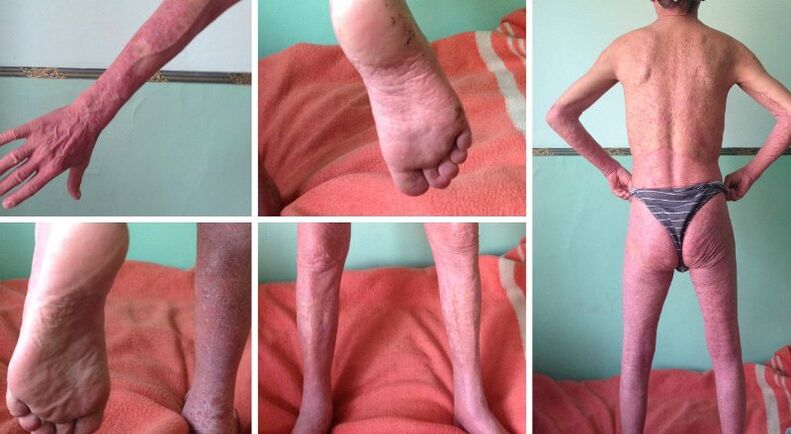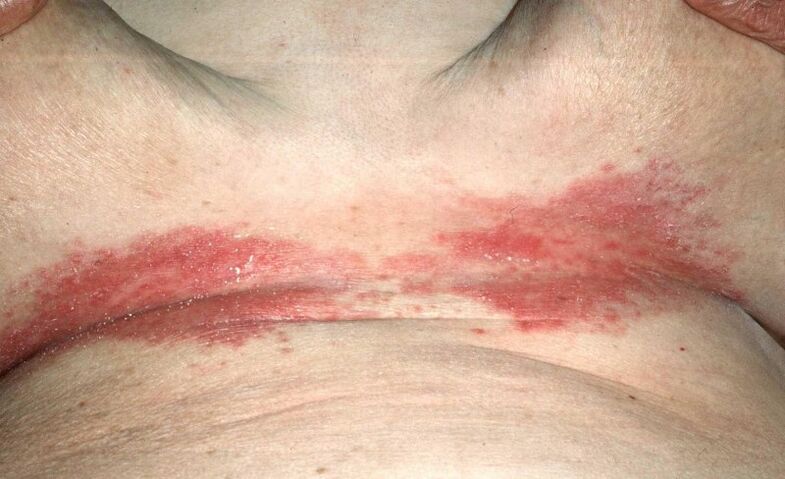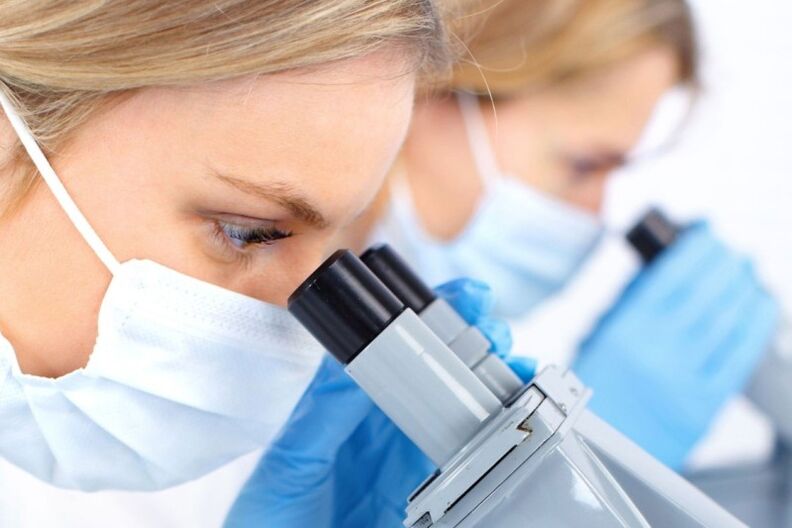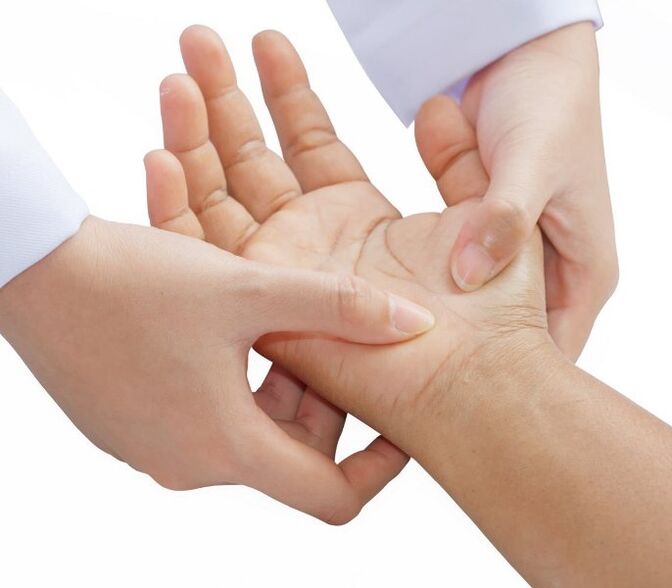Psoriasis is a common skin disease of neurogenic etiology. The disease is not contagious and does not spread from person to person. Most often, psoriasis becomes chronic due to its latent course. The disease usually develops in people under the age of 30, but can also occur in old age.
External symptoms may be absent, depending on the type and stage of the clinical picture of the disease. Most often, psoriasis begins with the appearance of bright red spots that are covered with dry scales, so the disease has a second name - flat lichen.
Skin patches can be of different sizes, some can coalesce into one of the affected areas of the skin and protrude significantly above the surface.
Psoriasis causes physical and mental discomfort to the patient, the disease worsens periodically, while a period of remission occurs and the symptoms improve.
Skin patches are called psoriatic plaques or papules, most commonly affecting the elbows and knees, and spread to the head and lumbar region. Plaques can affect other parts of the body, depending on the type of disease. The treatment can last for more than a year.
Causes of the disease

Psoriasis causes a number of causes that are related to various external and internal factors:
- a common cause is genetic inheritance;
- the disease can develop due to constant stress, anxiety, shock, depression, and mental disorders;
- various autoimmune diseases and failure of the immune system create ideal conditions on the surface of the skin for the development of the disease;
- Chronic psoriasis can also cause metabolic disorders as well as endocrine disorders.
The type and course of psoriasis depends on the etiology of the disease.
Classification of psoriasis

There are different forms of the disease, which depend on the external manifestation and symptoms:
- The most common form of the disease is scaly psoriasis. The surface of the skin is covered with red or pink spots, covered with scales. They are in stark contrast to healthy skin, denser and rise above the surface below them. The scaly layer can be easily removed and if disturbed, it will start to bleed, causing severe itching and burning. As the disease worsens, the spots can grow and merge with each other, forming large areas of damage.
- Guttate psoriasis looks different, the spots may be pink or purple in color, becoming lighter during the period of exacerbation. The scales may be larger and resemble drops in appearance, but may also merge over large areas.
- Another form of psoriasis that affects only the areas of the folds and folds of skin - the areas under the fat folds of the elbows, armpits, abdomen or chest, in the groin. The spots are smooth, even, not itchy and have no scales. If friction occurs with the clothing in the affected areas, the surface of the stains will be easily damaged.
- Chronic forms of nail psoriasis are also common, with the nail plate on the fingers or toes being affected. Nails lose their shape, deform and change color. The nails begin to thicken and peel, the disease can provoke the loss of the nail plate. In the initial stages, nail psoriasis can be easily confused with a fungal infection, so a doctor should be consulted for diagnosis and proper treatment.
- The most severe form of the disease is the pustular, which is characterized by blisters filled with light-colored liquid that can be easily broken by rubbing clothing. When the pustules are destroyed, pus is formed in them and a secondary infection of the skin occurs. This form of psoriasis is dangerous because it can affect almost the entire body, making its course worse.
- Rheumatoid psoriasis affects not only the surface of the skin but also the joints and periarticular soft tissues. This mainly affects the knee, shoulder and hip joints. The lesions manifest themselves not only in external symptoms but also in intra-joint pain, which causes additional suffering to the patient. If the hands or feet are affected, swelling of the fingers is observed, their sensitivity decreases and deformation begins. In the most severe and neglected form, the patient may lose limb sensitivity and become disabled.
All of these forms can develop on their own or appear together, depending on the severity of the disease.
Stages of psoriasis

There are different stages of the chronic form of the disease, each with its own symptoms and characteristics:
- in the progressive stage, the spots covered with scales appear and grow rapidly. They are usually red in color, but they can change their hue depending on the form of the disease. The skin in these places is very itchy, burning, and painful;
- at a stable stage, the disease does not cause painful feelings, it flows moderately, the scales grow gradually, they may merge periodically;
- in the regressive stage, the papules can resolve on their own, causing no concern other than external signs.
Psoriasis is a chronic disease that alternates between exacerbation and remission.
Causes of exacerbation

Exacerbation of the disease can be caused by a number of external and internal causes:
- prolonged cold effect by freezing the skin;
- violation of the body's hormonal background during puberty, pregnancy or menopause;
- long-term therapy with certain drugs (antibiotics), self-medication, dosing violations when taking complex vitamins and herbal supplements;
- the disease may be exacerbated by climate change or sunlight;
- alcohol abuse can not only exacerbate the disease but also complicate its course;
- trauma, burns, frostbite and other mechanical damage to the skin always cause exacerbation of psoriasis;
- infection by viruses and bacteria can cause an outbreak of the disease, sometimes a common respiratory illness can cause aggravation of skin diseases.
The rheumatic form of psoriasis has a seasonal exacerbation:
- in case of summer - day stay;
- in winter - due to hypothermia.
Ultraviolet rays help the papules heal, but the sun’s infrared rays irritate the skin.
Psoriasis is diagnosed without particular difficulty, the disease has vivid symptoms, and additional tests are performed in the form of blood tests and skin biopsies to rule out other diseases.
Treatment

Today’s medicine has taken great strides in the treatment of skin diseases, including psoriasis; several methods can be used to treat advanced forms of the disease. The physician determines the method of treatment on a purely individual basis, based on form, stage, causes, and symptoms. Treatment is always done in a comprehensive way, combining drug therapy and physiotherapy.
Medication includes the use of internal and external drugs:
- ointments based on salicylic acid, sulfur, ditranol and urea are used to eliminate skin pathologies;
- glucocorticoid ointments;
- creams for the treatment of the scalp.
In the exacerbation phase, hormonal ointments are used to eliminate the inflammatory process, and treatment is always started with less strong ones. If the disease begins to progress again, use strong fluorinated agents. It is used for two weeks to achieve the result.
Ointments with the fewest side effects are used for the elderly and children.
By increasing the dose, dithranol-based ointments are prescribed to eliminate the inflammatory process, itching and swelling.
Preparation with kalcipotriolexerts a direct therapeutic effect on pathogenetic provoking factors. It has anti-inflammatory and immunomodulatory effects. Usually, a treatment within two months has a noticeable positive result, the rash can disappear completely. This treatment has no side effects in the form of skin atrophy and has a lasting effect. The drug is used to treat a teardrop-shaped form of psoriasis that is difficult to treat.
All medications need to be replaced, otherwise addiction can occur and the body does not respond to them.
Treatment with aromatic retinoids is also considered effective.
In addition to drug therapy, you must meet a number of requirements for successful treatment:
- follow a diet;
- take the necessary vitamins under the supervision of a doctor;
- avoid stressful situations, in case of depression you should consult a doctor to prescribe the necessary funds;
- protect the affected areas from contact with chemicals as much as possible, especially hands and nails;
- wear only cotton clothing so as not to cause further skin irritation;
- do not consume alcoholic beverages and sweets and avoid contact with allergens.
If all recommendations and treatment rules are followed, it is possible to achieve remission of the disease and, in some cases, complete recovery.























